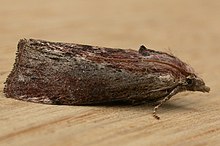Greater Wax Moth
| Galleria mellonella | |
|---|---|
 |
|
| Adult | |
| Scientific classification | |
| Kingdom: | Animalia |
| Phylum: | Arthropoda |
| Class: | Insecta |
| Order: | Lepidoptera |
| Family: | Pyralidae |
| Subfamily: | Galleriinae |
| Tribe: | Galleriini |
| Genus: |
Galleria Fabricius, 1798 |
| Species: | G. mellonella |
| Binomial name | |
|
Galleria mellonella (Linnaeus, 1758) |
|
| Synonyms | |
|
Numerous, see text |
|
Numerous, see text
Galleria mellonella, the greater wax moth or honeycomb moth, is a moth of the family Pyralidae. It is the only member of the genus Galleria. It is found in most of the world, including Europe and adjacent Eurasia, its presumed native range, and as an introduced species on other continents, including North America and Australia.
Its close relative, the lesser wax moth (Achroia grisella), is also a member of tribe Galleriini of the pyralid subfamily Galleriinae. The greater wax moth is the type species of this tribe and subfamily.
The adults' wingspan is 30–41 mm. This moth flies from May to October in the temperate parts of its range, such as Belgium and the Netherlands.
The caterpillar larvae, or waxworms, feed on the honeycomb inside bee nests and may become pests of apiculture. Less often, they are found in bumblebee and wasp nests, or feeding on dried figs. The larvae are commercially available. They can be used as food for the rearing of captive animals in terraria, such as geckos or predatory insects.
Vairimorpha ephestiae is a fungal parasite of the wax moth. Pseudomonas aeruginosa is also pathogenic to G. mellonella. The associations of virulence factors are the same for plant and animal infections.
...
Wikipedia
